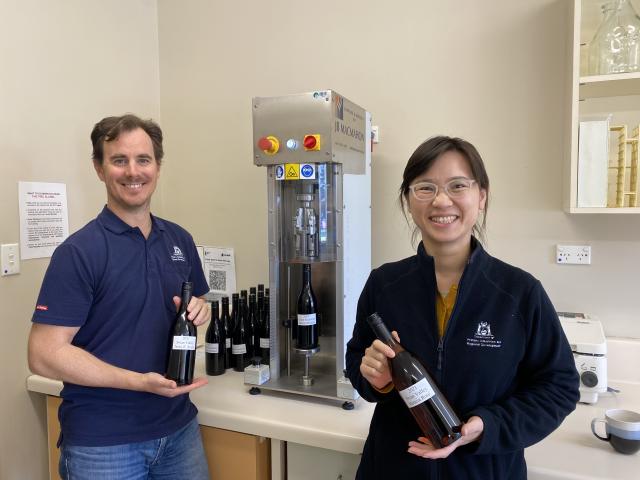DPIRD 2021 wine trials update
Swan Valley emerging varieties
Partnering with a Swan Valley producer with small parcels of emerging varieties, in the aim to demonstrate the performance of these varieties in the Swan Valley, the 2021 vintage for the DPIRD team began on 29 January with 30 kg of Mencía destined for rosé and 29 kg of Prosecco for sparkling. Another 36 kg of Mencía was picked on 19 February for table wine, along with 34 kg of Nero d’Avola.
Prosecco is most renowned for its ability to produce fresh, fruit-driven sparkling wines. Mencía is a red variety originating from Spain, known to produced deep coloured aromatic wines. Nero d’Avola hails from Sicily and is the most widely planted red variety in the region, popular due to its tolerance to heat, deep colour and ability to produce full bodied wines.
These wines have been bottled and will be presented to Swan Valley producers in an industry wine tasting later in the year.

Chardonnay winemaking trial
From a block of Chardonnay in Witchcliffe (Margaret River) 200 kg of fruit was harvested on 25 February and split into 12 different winemaking treatments to demonstrate the impact on wine quality and attributes. Treatments included skin contact, two different yeast strains, wild fermentation, high fermentation temperature, light solids, heavy solids, low diacetyl MLF, high diacetyl MLF and two other harvest dates (11 February and 3 March). These wines will be presented at regional wine tasting workshops later in the year.
Demonstrating the performance of three Merlot clones
Partnering with a Margaret River vineyard, three clones of Merlot (D3V14, 181, and Q45) were harvested (60 kg in total) and made into small lots to demonstrate the difference in wine quality and attributes between the clones. These wines will be presented at regional wine tasting workshops later in the year.
Demonstrating the impact of shading fruit on Shiraz wine qualities
A Frankland River vineyard has been using shade cloth over the fruiting zone to protect fruit from excessive sun exposure with observed benefits to wine quality. Fruit (25 kg) from adjacent rows without shade cloth, and with, were picked on 29 March and have been made into wine to demonstrate the impact of the treatment. These wines are being bottled in coming weeks and will be presented at regional wine tasting workshops later in the year.
Demonstrating how clonal selection can influence Cabernet Sauvignon wine quality
The first fruit (357 kg) off a trial block in Margaret River was harvested on 19 April. The block consists of 14 separate clones/selections grafted on matured SA126 Cabernet. The maturity and quality was influenced by an early April rain event, meaning the original plan to have clones/selections harvested at specific sugar levels was not achieved. Baume’s ranged from 12.6° to 13.5°, with an average of 13.1°. The plan is to bottle these parcels around mid-July for future industry tastings.
